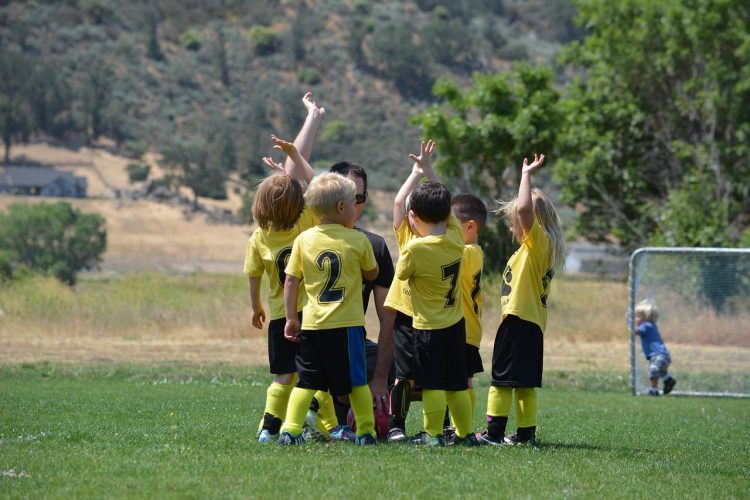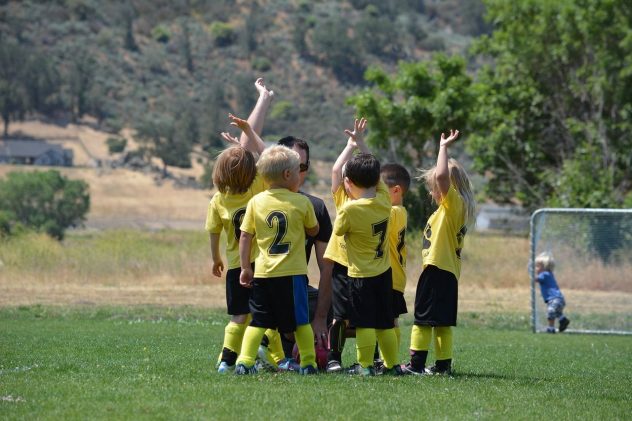By Dr. Tim Waddington
Walk any sideline on a mid-October Saturday morning and they’ll all tell you… watching your kids at mini-soccer is an easy conduit to happiness. Everywhere you look, you’ll see a field of shiny uniforms and happy flushed faces, representing teams with intimidating names like the Spiders, Vipers, Thunder and Tornados. With orange slices at halftime, and fruit roll ups and hot chocolate after the game, it’s pretty easy to feel good about life. Not quite grown into their oversized cleats and shin pads, children scurry up and down the field in a small mob around the ball, everyone trying to involve at least one big toe. Stick around five minutes and you’ll be sure to see one or two of them forget, right in the middle of the match, that they’re playing the world’s most beautiful game and instead start chasing moths, playing with loose bits of turf, and staring wondrously at the clouds in the sky. Cute-so.
The description above is a rite of passage, especially in families with an inter-generational involvement in the game, those families who understand that the key to later enjoyment is to start the kids off early, kicking and chasing and working out the dynamics of childhood (and society) in an environment characterized by both competition and common goals.
Being a coach to the small ones means accepting two very different settings, firstly a practice where one is able to isolate specific skills and develop the unique elements that carry each player throughout their career on the pitch and secondly a game where, for the first couple of years at least, most everything learned at practice will be abandoned in the momentary thrill of chasing, pushing and (hopefully) kicking the big goal. On the mini-pitch at least, egocentric thinking is a real thing and it cares not for considerations of basic bio-mechanics and the studious development of balance. It’s a long road to that magical 10,000 hours of expertise.
‘All very picturesque,’ you say, ‘but you promised PIRATES!!!’
Shiver m’ Timbers, so I did! Let us, then, introduce a few of the cognitive tools of Mythic Understanding, specifically mental images, jokes and humour, play, and metaphor. Let us, then, transform the practice gym into a pirate ship with a bow and stern, port and starboard sides, a growling Captain, barrels of water, and cannons to boot!
In building soccer fundamentals, a few skills stand out as most important. We want the children to be able to dribble under control, to be able to turn left and right, to develop competency with both feet, to understand that different parts of their feet can be utilized for distinct types of kicks and passes, to pull the ball back in order to change direction, and perhaps most difficult, to feel comfortable putting their feet (one at a time, preferably) on top of the ball. These are each complex and often challenging skills to develop, particularly once we ask our players to do them in combination.
Where this takes us in our scallywag motif is easy enough to imagine. We start with dribbling under control from port all the way to starboard, waiting until everyone gets there, and then back from starboard to port. As we add in the bow and stern, in different combinations, the players will naturally start to see the humour as they get confused, run into each other, and start to compete to get ‘there’ first. So long as the players are dribbling under control, the coach should feel free to modulate the speed and complexity of the activity (an expression of Dynamic Assessment within the Zone of Proximal Development).[1]
Having mastered the four directions, the coach can begin changing directions while the wee buccaneers are only half way across the ship – for example, half way from bow to stern, with the players all travelling at different speeds depending on their level of skill, the coach calls out ‘Port!’, causing all the players to turn right (except those that accidentally turn left!). Eventually, using this mediation, we will develop the players’ abilities to turn both left and right while dribbling the ball, using both their left and right feet, and using both the inside and outside of each foot.

From there, the remainder of the imaginatively engaged practice is just the introduction of new elements: “Captain on Deck” means stop the ball with one foot on top (an element of soccer ‘control’); “Dance the Jig” means switch back and forth placing the toes of each foot on top of the ball as if dancing (an element of ‘deception’); “Roll the Barrels Left and Right” means use the underside of the foot to roll the ball across the front of the body first one way and then the other (another element of ‘direction control’); “Release the Cannons” means take a hard shot against the wall with the top/laces of the boot (an element of ‘power’); “Man Overboard” means flop on the gym floor, pretending to frantically swim and scream for help (which, while terribly silly and fun for the children, has absolutely nothing to do with soccer outside certain Mediterranean national teams I could mention). Of course, one could add even more elements, so long as they are not introduced all at once. The principle of using successive approximations still applies as we initiate further complex skills.
I realize that to a certain extent I have taken the fun out of the activity describing it in this manner, but it’s not hard to imagine the opportunities this imaginative strategy has for combining emotional, intellectual, and somatic kinds of engagement while building the greater coordination and efficiency that will eventually be required in a team soccer environment. You can imagine a rocking boat in a storm-tossed sea, a madcap captain with a poor and inconsistent sense of direction, the need to avoid random obstacles that magically appear on deck! Remembering the SUSC Roadrunners (not the fiercest name, I’ll admit), “Captain on Deck” quickly devolved into “Captain Morgan!”, a dozen young boys with foot on ball and elbow on knee, all screwing up one eyeball tight and yelling “AAAAARRRRR!” in unison.
The imagination is alive EVERYWHERE, nowhere more so than in the play of children. We are all familiar with the notion of a “pivot” in children’s play, whereby a stick becomes an imaginary sword or the kitchen broom transforms into a horse to ride through the family room. The above example is not significantly different, except in its complexity and the fact that it’s operating in a reverse order. Whereas using a broom to imagine horse doesn’t actually teach one to ride the Dressage, imagining the training gym to be a massive pirate ship filled with adventures, jokes and any number of moving parts will actually serve to mediate the meaningful development of fundament soccer skills lasting long into the future.
Fun, Fitness and Friendship should be hallmarks of all sports for young children. It’s not about the final scores and it’s definitely not about one parent’s need to have their kid be better than the kid of the other parents. By the time they’re in the back seat and two blocks into the drive home, the kids don’t remember what the final score was anyways. To all coaches and primary teachers, “Engage the Imagination!” Your players’ skills will develop quicker, your drills will last longer, and your practices will transfer much more effectively to actual game situations.
“Now that’s a pirate’s golden treasure, Mateys! AAAAARRRRR!!!”
[1] While it is doubtful that Vygotsky contemplated ZPD and DA in the development of increasing football skills, the basic principle nevertheless can be extrapolated across contexts quite easily. For further research, consider chapter 6 in Vygotsky’s Mind and Society, particularly pages 85-87.
 Also by Dr. Tim Waddington
Also by Dr. Tim Waddington
Look Out! A Spontaneous Eruption Of Cognitive Tools!
Aristotle And A Leather Jacket: An Example Of Concept-Centered Teaching





Shiver me timbers, Tim! Brilliant use of cognitive tools as usual.
Thanks Judy. Not quite high-level science, but it sure does the trick. An extra portion of rum for you!
Dr. Waddington.
An excellent way to describe how imagination way can be used in a common experience for a number of young children to engage them in sports. Success in any activity is always a building block for the next challenge a child engages in.
I have subscribed and look forward to receiving further articles.
Rhoda Marie Waddington, B.S.W., Trained Play Therapist.